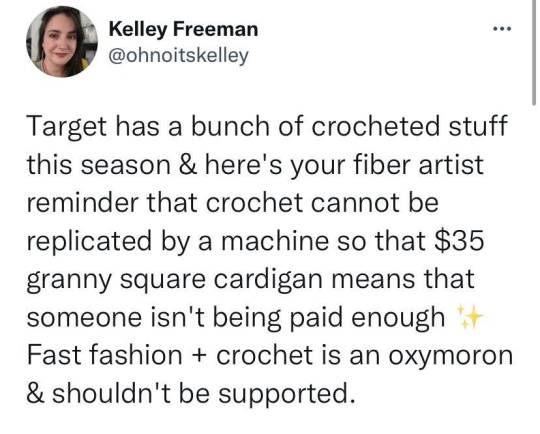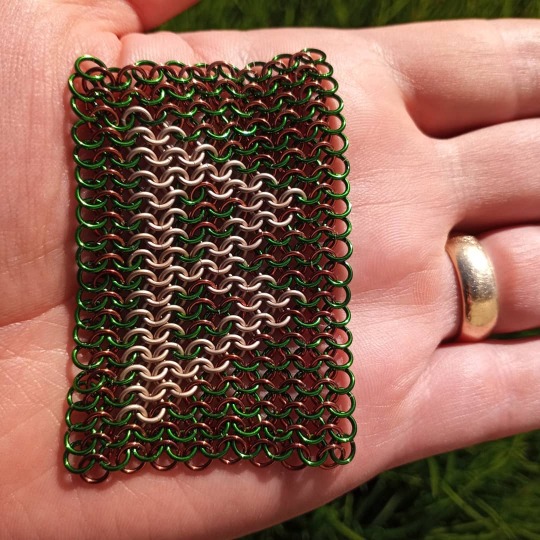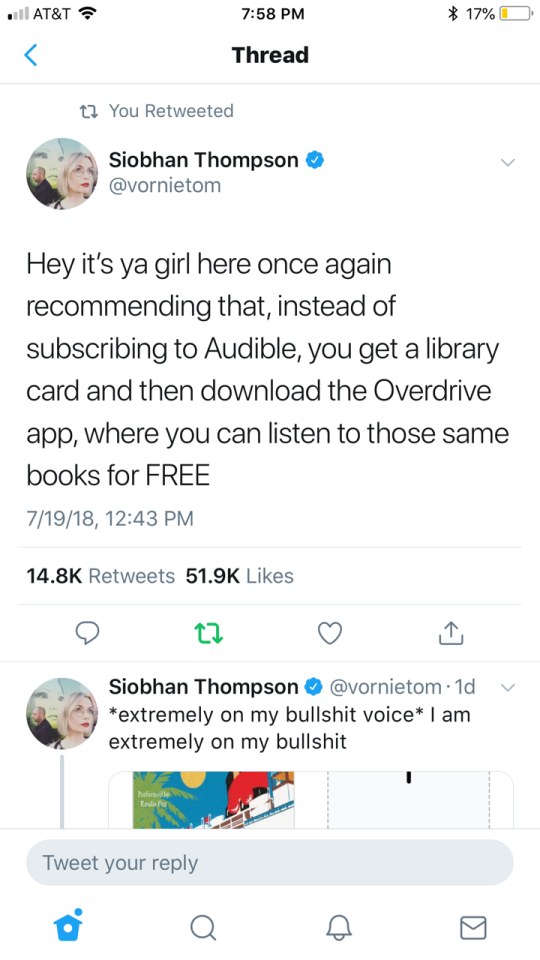Don't wanna be here? Send us removal request.
Text
Sharing this because I also feel as a fibre artist that the prospect of a granny square cardigan being sold for $35 means that someone somewhere is being exploited and criminally underpaid. That person doesn't have to exist in my geographic location for me to care about that.

25K notes
·
View notes
Photo
Isn't the point that it's more difficult to have that conversation now?

(via zu2ym6d86r0a1.jpg (JPEG Image, 1132 × 992 pixels))
25K notes
·
View notes
Text
It was all downhill after the Cuecat

Sometime in 2001, I walked into a Radio Shack on San Francisco’s Market Street and asked for a Cuecat: a handheld barcode scanner that looked a bit like a cat and a bit like a sex toy. The clerk handed one over to me and I left, feeling a little giddy. I didn’t have to pay a cent.
The Cuecat was a good idea and a terrible idea. The good idea was to widely distribute barcode scanners to computer owners, along with software that could read and decode barcodes; the company’s marketing plan called for magazines and newspapers to print barcodes alongside ads and articles, so readers could scan them and be taken to the digital edition. To get the Cuecat into widespread use, the company raised millions in the capital markets, then mass-manufactured these things and gave them away for free at Radio Shacks around the country. Every Wired and Forbes subscriber got one in the mail!
That was the good idea (it’s basically a prototype for today’s QR-codes). The terrible idea was that this gadget would spy on you. Also, it would only work with special barcodes that had to be licensed from the manufacturer. Also, it would only work on Windows.
https://web.archive.org/web/20001017162623/http://www.businessweek.com/bwdaily/dnflash/sep2000/nf20000928_029.htm
But the manufacturer didn’t have the last word! Not at all. A couple of enterprising hardware hackers — Pierre-Philippe Coupard and Michael Rothwell — tore down a Cuecat, dumped its ROM, and produced their own driver for it — a surveillance-free driver that worked with any barcode. You could use it to scan the UPCs on your books or CDs or DVDs to create a catalog of your media; you could use it to scan UPCs on your groceries to make a shopping list. You could do any and every one of these things, because the Cuecat was yours.
Cuecat’s manufacturer, Digital Convergence, did not like this at all. They sent out legal demand letters and even shut down some of the repositories that were hosting alternative Cuecat firmware. They changed the license agreement that came with the Cuecat software CD to prohibit reverse-engineering.
http://www.cexx.org/cuecat.htm
It didn’t matter, both as a practical matter and as a matter of law. As a practical matter, the (ahem) cat was out of the bag: there were so many web-hosting companies back then, and people mirrored the code to so many of them, the company would have its hands full chasing them all down and intimidating them into removing the code.
Then there was the law: how could you impose license terms on a gift? How could someone be bound by license terms on a CD that they simply threw away without ever opening it, much less putting it in their computer?
https://slashdot.org/story/00/09/18/1129226/digital-convergence-changes-eula-and-gets-cracked
In the end, Cuecat folded and sold off its remaining inventory. The early 2000s were not a good time to be a tech company, much less a tech company whose business model required millions of people to meekly accept a bad bargain.
Back then, tech users didn’t feel any obligation to please tech companies’ shareholders: if they backed a stupid business, that was their problem, not ours. Venture capitalists were capitalists — if they wanted us give to them according to their need and take from them according to their ability, they should be venture communists.
Last August, philosopher and Centre for Technomoral Futures director Shannon Vallor tweeted, “The saddest thing for me about modern tech’s long spiral into user manipulation and surveillance is how it has just slowly killed off the joy that people like me used to feel about new tech. Every product Meta or Amazon announces makes the future seem bleaker and grayer.”
https://twitter.com/ShannonVallor/status/1559659655097376768
She went on: “I don’t think it’s just my nostalgia, is it? There’s no longer anything being promised to us by tech companies that we actually need or asked for. Just more monitoring, more nudging, more draining of our data, our time, our joy.”
https://twitter.com/ShannonVallor/status/1559663985821106177
Today on Tumblr, @wilwheaton responded: “[T]here is very much no longer a feeling of ‘How can this change/improve my life?’ and a constant dread of ‘How will this complicate things as I try to maintain privacy and sanity in a world that demands I have this thing to operate.’”
https://wilwheaton.tumblr.com/post/698603648058556416/cory-doctorow-if-you-see-this-and-have-thoughts
Wil finished with, “Cory Doctorow, if you see this and have thoughts, I would LOVE to hear them.”
I’ve got thoughts. I think this all comes back to the Cuecat.
When the Cuecat launched, it was a mixed bag. That’s generally true of technology — or, indeed, any product or service. No matter how many variations a corporation offers, they can never anticipate all the ways that you will want or need to use their technology. This is especially true for the users the company values the least — poor people, people in the global south, women, sex workers, etc.
That’s what makes the phrase “So easy your mom can use it” particularly awful “Moms” are the kinds of people whose priorities and difficulties are absent from the room when tech designers gather to plan their next product. The needs of “moms” are mostly met by mastering, configuring and adapting technology, because tech doesn’t work out of the box for them:
https://pluralistic.net/2022/05/19/the-weakest-link/#moms-are-ninjas
(As an alternative, I advocate for “so easy your boss can use it,” because your boss gets to call up the IT department and shout, “I don’t care what it takes, just make it work!” Your boss can solve problems through raw exercise of authority, without recourse to ingenuity.)
Technology can’t be understood separately from technology users. This is the key insight in Donald Norman’s 2004 book Emotional Design, which argued that the ground state of all technology is broken, and the overarching task of tech users is to troubleshoot the things they use:
https://pluralistic.net/2020/04/29/banjo-nazis/#cuckoos-egg
Troubleshooting is both an art and a science: it requires both a methodical approach and creative leaps. The great crisis of troubleshooting is that the more frustrated and angry you are, the harder it is to be methodical or creative. Anger turns attention into a narrow tunnel of brittle movements and thinking.
In Emotional Design, Norman argues that technology should be beautiful and charming, because when you like a technology that has stopped working, you are able to troubleshoot it in an expansive, creative, way. Emotional Design was not merely remarkable for what it said, but for who said it.
Donald Norman, after all, was the author of the hugely influential 1998 classic The Design of Everyday Things, which counseled engineers and designers to put function over form — to design things that work well, even if that meant stripping away ornament and sidelining aesthetics.
https://www.basicbooks.com/titles/don-norman/the-design-of-everyday-things/9780465050659/
With Emotional Design, Norman argued that aesthetics were functional, because aesthetics primed users to fix the oversights and errors and blind spots of designers. It was a manifesto for competence and humility.
And yet, as digital technology has permeated deeper into our lives, it has grown less configurable, not more. Companies today succeed where Cuecat failed. Consolidation in the online world means that if you remove a link from one search engine and four social media sites, the material in question vanishes for 99% of internet users.
It’s even worse for apps: anyone who succeeds in removing an app from two app stores essentially banishes it from the world. One mobile platform uses technological and legal countermeasures to make it virtually impossible to sideload an app; the other one relies on strong-arm tactics and deceptive warnings to do so.
That means that when a modern Coupard and Rothwell decides to unfuck some piece of technology — to excise the surveillance and proprietary media requirements, leaving behind the welcome functionality — they can only do so with the sufferance of the manufacturer. If the manufacturer doesn’t like an add-on, mod, plug-in or overlay, they can use copyright takedowns, anticircumvention law, patent threats, trademark threats, cybersecurity law, contract law and other “IP” to simply banish the offending code:
https://locusmag.com/2020/09/cory-doctorow-ip/
Many of these laws carry dire penalties. For example, distributing a tool that bypasses an “access control” so that you can change the software on a gadget (say, to make your printer accept third-party ink) is a felony under Section 1201 of the DMCA, punishable by a $500k fine and a 5-year prison sentence.
If Cuecat’s manufacturers had simply skinned their firmware with a thin scrim of DRM, they could have threatened Coupard and Rothwell with prison sentences. The developments in “IP” over the two decades since the Cuecat have conjured up a new body of de facto law that Jay Freeman calls “felony contempt of business model.”
Once we gave companies the power to literally criminalize the reconfiguration of their products, everything changed. In the Cuecat era, a corporate meeting to plan a product that acted against its users’ interests had to ask, “How will we sweeten the pot and/or obfuscate our code so that our users don’t remove the anti-features we’re planning to harm them with?”
But in a world of Felony Contempt of Business Model, that discussion changes to “Given that we can literally imprison anyone who helps our users get more out of this product, how can we punish users who are disloyal enough to simply quit our service or switch away from our product?”
That is, “how can we raise the switching costs of our products so that users who are angry at us keep using our products?” When Facebook was planning its photos product, they deliberately designed it to tempt users into making it the sole repository of their family photos, in order to hold those photos ransom to keep Facebook users from quitting for G+:
https://www.eff.org/deeplinks/2021/08/facebooks-secret-war-switching-costs
Companies claim that their lock-in strategies are about protecting their users: “Move into our walled garden, for it is a fortress, whose battlements bristle with fearsome warriors who will defend you from the bandits who roam the countryside”:
https://locusmag.com/2021/01/cory-doctorow-neofeudalism-and-the-digital-manor/
But this “feudal security” offers a terrible temptation to the lords of these fortresses, because once you are inside those walls, the fortress can easily be converted to a prison: these companies can abuse you with impunity, for so long as the cost of the abuse is less than the cost of the things you must give up when you leave.
The tale that companies block you from overriding their decisions is for your own good was always dubious, because companies simply can’t anticipate all the ways their products will fail you. No design team knows as much about your moment-to-moment struggles as you do.
But even where companies are sincere in their desire to be the most benevolent of dictators, the gun on the mantelpiece in Act I is destined to go off by Act III: eventually, the temptation to profit by hurting you will overpower whatever “corporate ethics” once stayed the hand of the techno-feudalist who rules over your fortress. Under feudal security, you are one lapse in corporate leadership from your protector turning into your tormentor.
When Apple launched the Ipad 12 years ago, I published an editorial entitled “Why I won’t buy an iPad (and think you shouldn’t, either),” in which I predicted that app stores would inevitable be turned against users:
https://memex.craphound.com/2010/04/01/why-i-wont-buy-an-ipad-and-think-you-shouldnt-either/
Today, Apple bans apps if they “use…a third-party service” unless they “are specifically permitted to do so under the service’s terms of use.” In other words, Apple specifically prohibits developers from offering tools that displease other companies’ shareholders, no matter whether this pleases Apple customers:
https://developer.apple.com/app-store/review/guidelines/#intellectual-property
Note that clause 5.2.2 of Apple’s developer agreement doesn’t say “You mustn’t violate a legally enforceable term of service.” It just says, “Thou shalt not violate a EULA.” EULAs are garbage-novellas of impenetrable legalese, larded with unenforceable and unconscionable terms.
Apple sometimes will displease other companies on your behalf. For example, it instituted a one-click anti-tracking setting for Ios that cost Facebook $10 billion in a matter of months:
https://www.cnbc.com/2022/02/02/facebook-says-apple-ios-privacy-change-will-cost-10-billion-this-year.html
But Apple also has big plans to expand its margins by growing its own advertising network. When Apple customers choose ad-blockers that block Apple’s ads, will Apple permit it?
https://www.wired.com/story/apple-is-an-ad-company-now/
The problem with app stores isn’t whether your computing experience is “curated” — that is, whether entities you trust can produce collections of software they vouch for. The problem is when you can’t choose someone else — when leaving a platform involves high switching costs, whether that’s having to replace hardware, buy new media, or say goodbye to your friends, customers, community or family.
When a company can leverage its claims to protecting you to protect itself from you — from choices you might make that ultimately undermine its shareholders interests, even if they protect your own interests — it would be pretty goddamned naive to expect it to do otherwise.
More and more of our tools are now digital tools, whether we’re talking about social media or cars, tractors or games consoles, toothbrushes or ovens:
https://www.hln.be/economie/gentse-foodboxleverancier-mealhero-failliet-klanten-weten-van-niets~a3139f52/
And more and more, those digital tools look more like apps than Cuecats, with companies leveraging “IP” to let them control who can compete with them — and how. Indeed, browsers are becoming more app-like, rather than the other way around.
Back in 2017, the W3C took the unprecedented step of publishing a DRM standard despite this standard not having anything like the consensus that is the norm for W3C publications, and the W3C rejected a proposal to protect people who reverse-engineered that standard to add accessibility features or correct privacy defects:
https://www.eff.org/deeplinks/2017/09/open-letter-w3c-director-ceo-team-and-membership
And while we’re seeing remarkable progress on Right to Repair and other policies that allow the users of technology to override the choices of vendors, there’s another strong regulatory current that embraces companies’ ability to control their users, in the hopes that these big companies will police their users to prevent bad stuff, from controversial measures like filtering for copyright infringement to more widely supported ideas like blocking child sex abuse material (CSAM, AKA “child porn”).
There are two problems with this. First, if we tell companies they must control their users (that is, block them from running plugins, mods, skins, filters, etc) then we can’t tell them that they must not control their users. It comes down to whether you want to make Mark Zuckerberg better at his job, or whether you want to abolish the job of “Mark Zuckerberg.”
https://doctorow.medium.com/unspeakable-8c7bbd4974bc
Then there’s the other problem — the gun on the mantelpiece problem. If we give big companies the power to control their users, they will face enormous internal pressure to abuse that power. This isn’t a hypothetical risk: Facebook’s top executives stand accused of accepting bribes from Onlyfans in exchange for adding performers who left Onlyfans to a terrorist watchlist, which meant they couldn’t use other platforms:
https://gizmodo.com/clegg-meta-executives-identified-in-onlyfans-bribery-su-1849649270
I’m not a fan of terrorist watchlists, for obvious reasons. But letting Facebook manage the terrorist watchlist was clearly a mistake. But Facebook’s status as a “trusted reporter” grows directly out of Facebook’s good work on moderation. The lesson is the same as the one with Apple and the ads — just because the company sometimes acts in our interests, it doesn’t follow that we should always trust them to do so.
Back to Shannon Vallor’s question about the origins of “modern tech’s long spiral into user manipulation and surveillance” and how that “killed off the joy that people like me used to feel about new tech”; and Wil Wheaton’s “constant dread of ‘How will this complicate things as I try to maintain privacy and sanity.”
Tech leaders didn’t get stupider or crueler since those halcyon days. The tech industry was and is filled with people who made their bones building weapons of mass destruction for the military-industrial complex; IBM, the company that gave us the PC, built the tabulating machines for Nazi concentration camps:
https://en.wikipedia.org/wiki/IBM_and_the_Holocaust
We didn’t replace tech investors and leaders with worse people — we have the same kinds of people but we let them get away with more. We let them buy up all their competitors. We let them use the law to lock out competitors they couldn’t buy, including those who would offer their customers tools to lower their switching costs and block abusive anti-features.
We decided to create “Felony Contempt of Business Model,” and let the creators of the next Cuecat reach beyond the walls of their corporate headquarters and into the homes of their customers, the offices of their competitors, and the handful of giant tech sites that control our online discourse, to reach into those places and strangle anything that interfered with their commercial desires.
That’s why plans to impose interoperability on tech giants are so exciting — because the problem with Facebook isn’t “the people I want to speak to are all gathered in one convenient place,” no more than the problem with app stores isn’t “these companies generally have good judgment about which apps I want to use.”
The problem is that when those companies don’t have your back, you have to pay a blisteringly high price to leave their walled gardens. That’s where interop comes in. Think of how an interoperable Facebook could let you leave behind Zuckerberg’s dominion without forswearing access to the people who matter to you:
https://www.eff.org/interoperablefacebook
Cuecats were cool. The people who made them were assholes. Interop meant that you could get the cool gadget and tell the assholes to fuck off. We have lost the ability to do so, little by little, for decades, and that’s why a new technology that seems cool no longer excites. That’s why we feel dread — because we know that a cool technology is just bait to lure us into a prison that masquerades as a fortress.
Image: Jerry Whiting (modified) https://en.wikipedia.org/wiki/File:CueCat_barcode_scanner.jpg
CC BY-SA 3.0: https://creativecommons.org/licenses/by-sa/3.0/deed.en
[Image ID: A Cuecat scanner with a bundled cable and PS/2 adapter; it resembles a plastic cat and also, slightly, a sex toy. It is posed on a Matrix movie ‘code waterfall’ background and limned by a green 'supernova’ light effect.]
7K notes
·
View notes
Text
Yessssssss.
I just want to dwell a little bit on the raw awe that the Webb telescope pictures evoke in me. We built a thing, we spent 20 years building a thing, and we flung it over a million kilometres away, and the thing we built takes … pictures of infinity. Pictures of 13 billion years in the past, pictures of the birth and death of stars, galaxies colliding, snapshots of other worlds. Lightyears of distance, aeons of time, glories almost beyond imagining.
This is a thing humanity can do. We can pool imagination, we can pool resources, we can devote decades of our lives, to building a camera that can photograph infinity. We can reach out, fling a piece of ourselves, our ingenuity, our dedication, our collaboration, our imagination, and create a lens so that we can see, we can touch …
There are people who say that pictures like this make them feel small, so tiny in comparison to the vastness that’s out there, but we touched that vastness. We took its picture. We put our palms on the panes of infinity. We flung a tiny tiny fragile machine, a collection of mirrors and motors and shields and fuel, out into the absolute vastness of space, more than a million kilometers distant, and took a picture of a dying star orbiting its partner two thousand lightyears away.
I mean, yes, we are tiny, we are incomprehensibly tiny, and so is everything we do and everything we build. But all that shows is that something so tiny can still do that. Can reach that far. Can witness that much.
We are incomprehensibly tiny and an incomprehensible miracle, that we can be so tiny in all this vastness, that everything we witness in these pictures aligned in such a way that we could form, and that in response, as tiny as we are, we can think and imagine and create on a scale that can … witness the universe right back. Touch it. Focus its light into an image of a billion, thirteen billion years ago. Share that image with a billion other minds.
We can see wonders. Absolute wonders. On a scale to beggar meaning. What more purpose do we need than that?
Sorry. Just. Sometimes science does something that just … wraps a whole fist around your heart and just goes … this is what wonder is. The wonder of the universe. And the wonder of us. This is what wonder feels like. This is what awe feels like.
This is what it feels like to be tiny. This is what it feels like to be infinite.
I love the stars so much.
12K notes
·
View notes
Text
in october of 2016, the parliament of Poland enacted a total ban on abortion with 5 years prison time as punishment.
millions of women across the country went on strike from their jobs in response. not only did they strike from their places of work, hundreds of thousands struck from their "home duties" as well.
they removed their productive effort from the economy, and they removed their caring, unpaid reproductive labor from their homes.
the parliament capitulated almost immediately, reversing course and admitting they had been "taught humility".
if you are angry and frustrated and scared, take that impetus and organise. talk to everyone you know, ask how they feel. are they angry? are they scared? do they recognise the incredible power we all have when we join together and withhold our labor?
i use Poland as an example because it worked so well and so instantly.
it is already clear that this is only the first step for these judges. every shred of safety and dignity our lgbtqia+ community have struggled for is next on the chopping block, along with legal contraception and who knows what else.
this is an excellent opportunity to flex our power and show them that we will not roll over and show our bellies.
if you need help organising, the iww has a free and exhaustive training.
11K notes
·
View notes
Text
Forests are good to think because they themselves think. Forests think. […]
[O]ne’s ability to destroy other selves rests on and also highlights the fact that one is an ephemeral self – a self that can all too quickly cease being a self. […] That death is intrinsic to life exemplifies […] a “difficulty of reality.” […] And this difficulty […] is compounded by another one: such contradictions are at times, and for some, completely unremarkable. […]
[T]he “little deaths” of “everyday life” […]. There are many kinds and scales of death. […] There are many ways of being pulled out of relation and many occasions where we turn a blind eye to and even kill relation. […] At times the horror of this everyday fact of our existence bursts into our lives, and thus becomes a difficulty of reality. At others it is simply ignored.
——-
Not all these entities are artifacts. Nor are all kinds of selves human. […] [W]hat we share with jaguars and other living selves – whether bacterial, floral, fungal, or animal – is the fact that how we represent the world around us is in some way or another constitutive of our being. […] This more expansive understanding of representation is hard to appreciate because our social theory – whether humanist or posthumanist, structuralist or poststructuralist – conflates representation with language. […] In addition to being symbolic creatures we humans share […] other semiotic modalities with the rest of nonhuman biological life […]. Being aware of the selfhood of the many beings that people the cosmos poses particular challenges. […]
[There is] the problem of how to safely and successfully communicate with the many kinds of beings that people the cosmos. […] And when successful, communication with these beings can be destabilizing. Communication, to an extent, always involves communion. That is, communicating with others entails some measure of […] “becoming with” these others. […]
In a tropical forest teeming with so many forms of life these patterns proliferate to an unprecedented degree. To engage with the forest on its terms, to enter its relational logic, to think with its thoughts […].
——-
[S]igns represent a future possible state of affairs. The future matters to living thoughts. […] Signs are oriented toward the ways in which future signs will likely represent their relationship to a likely state of affairs. […] In the life of signs future is also closely related to absence. All kinds of signs in some way or other re-present what is not present. And every successful representation has another absence at its foundation; it is the product of the history of all the other processes that less accurately represented what would be. […]
One’s future emerges from and in relation to a specific geometry of absent histories. Living futures are always “indebted” to the dead that surround them. […]
[I]t is a dynamic that is amplified in the tropical forest, with its unprecedented layers of mutually constitutive relationships. […] A […] realm that is the emergent product of the […] futures and pasts that the forest comes to harbor in its relational webs. […]
This other kind of “beyond,” this after-life, this super-nature, is not exactly natural (or cultural), but it is nonetheless real. It is its own kind of irreducible real, […] with its own tangible effects in a future present. […] This […] realm of continuity and possibility is the emergent product of a whole host of trans-species and trans-historical relations. It is the product of the imponderable weight of the many dead that make a living future possible.
——-
Eduardo Kohn. How Forests Think. 2013
232 notes
·
View notes
Photo

...And back around to the half month of #Fehu. I ended up reproducing this rune as the first one found a new home, and I'm petty stoked on this new one anyhow. Now I'm through the elder futhark I'll get back to posting jewelry again soon :) . . . #3earringcircus #torusdwr #chainmaille #chainmail #fehu #fehurune #elderfuthark #futharkrunes #aluminumfuthark #aluminumrunes #handmaderunesfromaluminumjumprings #pnwmade #pnwmaderunes #pnwcraft #aluminumfehu https://www.instagram.com/p/CRFj7AiBzGm/?utm_medium=tumblr
#fehu#3earringcircus#torusdwr#chainmaille#chainmail#fehurune#elderfuthark#futharkrunes#aluminumfuthark#aluminumrunes#handmaderunesfromaluminumjumprings#pnwmade#pnwmaderunes#pnwcraft#aluminumfehu
5 notes
·
View notes
Photo

Othala. Significant of inheritance. I notice the similarity with Inguz (see prev. post). Where Inguz represents a seed, or container of potential, this rune begins the realization of that potential; the seed putting out the first tendrils of root and stem. To root into place, claiming its spot in the sun, stepping on deck as best it can in the conditions created by those who came before. To form seeds of its own, and/or to exist as a facet of the Whole, enriching the lived experience of all things. . . . #3earringcircus #torusdwr #chainmaille #chainmail #chainmaillerunes #chainmailrunes #chainmailleothala #chainmailothala #othala #othalarune #futhark #elderfuthark #aluminumrunes #aluminumothala #handcraftedrunes #handmaderunesfromaluminumjumprings #pnwmade #pnwmaderunes #roots #growth #inheritance #Illusoryduality #uniquebutpartofthewhole (at Unceded Chinookan Territory) https://www.instagram.com/p/CPosgvgBzMF/?utm_medium=tumblr
#3earringcircus#torusdwr#chainmaille#chainmail#chainmaillerunes#chainmailrunes#chainmailleothala#chainmailothala#othala#othalarune#futhark#elderfuthark#aluminumrunes#aluminumothala#handcraftedrunes#handmaderunesfromaluminumjumprings#pnwmade#pnwmaderunes#roots#growth#inheritance#illusoryduality#uniquebutpartofthewhole
0 notes
Video
instagram
We're in the half month of Laguz. Hear that April showers? Where u at? https://www.instagram.com/p/COTsErdhvqC/?igshid=qntbfeuudwqr
0 notes
Video
youtube
How to Stop Republicans from Stealing Elections
Republican-controlled state legislatures have introduced over 361 voter suppression bills in 47 states, and some states, like Georgia, have already enacted them into law.
There’s only one way to stop this assault on our democracy. It’s called the FOR THE PEOPLE ACT, and the window for Congress to pass it is closing.
These Republican voter suppression bills are egregious —they shrink early voting periods, add onerous voter ID requirements, limit eligibility for mail-in ballots, ban ballot drop boxes and drive-through voting, and even make it a crime to give voters in line water.
The FOR THE PEOPLE ACT, on the other hand, would prevent these tactics and make it easier to vote. In addition, gerrymandering would be reduced and the power of small political donors would be amplified.
It could not come at a more critical time.
The Republican assault on our democracy is based on the lie that there was widespread voter fraud in the 2020 election. Multiple recounts in battleground states like Georgia found nothing. Investigations by the Department of Homeland Security and the Justice Department found nothing. 61 out of 62 courts found nothing.
Republicans claim they’re just listening to the concerns of their voters and restoring “trust” in our elections. Rubbish. The real purpose of these restrictions is to hamper voting by Black people, people of color, young people, and lower-income Americans.
After Black voters and organizers in Georgia flipped the state blue for the first time in decades, the GOP is pulling out all the stops to prevent the same from happening in other states. The situation is even more dire given the upcoming once-in-a-decade redistricting process, allowing Republican-controlled states to further gerrymander congressional districts.
Their assault on the right to vote is a coordinated, national strategy led by top party leaders and outside dark-money advocacy groups like the Heritage Foundation. That group is working directly with state legislatures to provide them with “model legislation” and gearing up to spend $24 million in eight states to advance these bills ahead of the midterms.
Unless the FOR THE PEOPLE ACT becomes law, these restrictive state bills will go into effect before the upcoming 2022 midterm elections, and entrench Republican power for years to come. So it’s essential we protect voting rights now, while we still can.
This is not a partisan fight. It’s a battle between forces that want to go backward to an era of Jim Crow, and the majority of Americans who want to build a more inclusive democracy.
Yet the FOR THE PEOPLE ACT faces an uphill battle in the Senate because of the archaic filibuster rule that requires a 60-vote supermajority to pass legislation.
The good news is Senate Democrats have the power to end the filibuster and thereby allow the FOR THE PEOPLE ACT to become law. It’s time for Democrats to unite on this, without hesitation.
The stakes could not be higher. Simply put, it’s democracy or authoritarianism.
796 notes
·
View notes
Photo

Moving into the half month of Mannaz, or 'wunjo self reflecting,' or 'gebo on stilts.' I've been working on other pieces but I've also been having a difficult time staying positive about the media platforms we've made for ourselves, not much wanting to participate in the Spectacle. I'll work it out somehow bc I do want to share my work... p.s. I do still enjoy seeing all your work . . . #3earringcircus #torusdwr #chainmaille #altarpiece #futhark #elderfuthark #chainmaillealtarpiece #chainmaillefuthark #aluminumrunes #pnwmade #pnwruneset #pnwcraft #mannaz #mannazrune #aluminumannaz https://www.instagram.com/p/CNp8wpVB1dM/?igshid=szq07hv8albn
#3earringcircus#torusdwr#chainmaille#altarpiece#futhark#elderfuthark#chainmaillealtarpiece#chainmaillefuthark#aluminumrunes#pnwmade#pnwruneset#pnwcraft#mannaz#mannazrune#aluminumannaz
0 notes
Photo

Today is the beginning of the half-month of ehwaz. Be cool everybody. . . . #3earringcircus #torusdwr #chainmaille #chainmail #futhark #elderfuthark #ehwaz #rune #ehwazrune #aluminumfuthark #aluminumrunes #handcraftedrunes #runesmadeofmetal https://www.instagram.com/p/CNDih3Ghe55/?igshid=dgrs0ztsvh25
#3earringcircus#torusdwr#chainmaille#chainmail#futhark#elderfuthark#ehwaz#rune#ehwazrune#aluminumfuthark#aluminumrunes#handcraftedrunes#runesmadeofmetal
0 notes
Photo

Berkano, the birch tree Technical spring for the northern hemisphere is still more than week out, but all the plants and animals in my yard were talking about it today. How is it looking where you are? What's leafing out? What's blooming? Who's sifting through your leaf litter for snacks? . . . #3earringcircus #torusdwr #runes #elderfuthark #futharkrunes #berkano #aluminumfuthark #aluminumrunes #handcraftedrunes #handmaderunes #handmaderunesfromaluminumjumprings #pnwmade #pnwmaderunes #pnwcraft #eostre #freya #frigg #nerthus #hel #holda #berchta #perchta #percht https://www.instagram.com/p/CMQkn_DB_YG/?igshid=1oiujmi4j8ec7
#3earringcircus#torusdwr#runes#elderfuthark#futharkrunes#berkano#aluminumfuthark#aluminumrunes#handcraftedrunes#handmaderunes#handmaderunesfromaluminumjumprings#pnwmade#pnwmaderunes#pnwcraft#eostre#freya#frigg#nerthus#hel#holda#berchta#perchta#percht
0 notes



